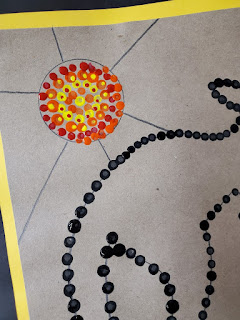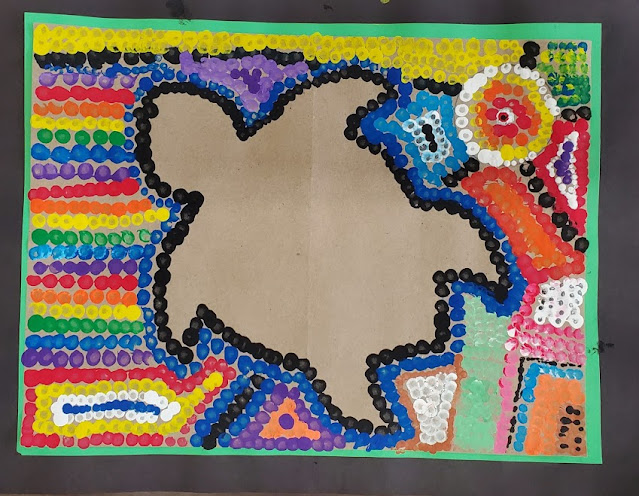Fourth Grade Art Lesson
3 Class Periods
50 minutes per class
About Aborigine Art:
The Aborigine Culture dates back to 80,000 years ago. Most Aboriginal artwork is based on story telling or what they refer to as "The Dreaming." The artwork is usually depicted in an aerial viewpoint, as if you are looking down upon the object. The paintings often tell the story of their knowledge of the land, events that happen to them or their beliefs. An Aboriginal artists cannot paint a story, event or a belief that does not belong to them or their family. This is what makes their artwork so personal and unique to the artist.
Day 1:
As a class we discuss the Aborigine culture and look at numerous example of Aborigine Dot painting. After our discussion, we begin the set up of our dot painting. First we mount a piece of brown Kraft paper to a piece of colored construction paper. This piece is then mounted to a black piece of construction paper. Make sure students labeled the composition with their name on the back. We use silver sharpies for this step.
Next, I created numerous silhouette drawings of animals that are commonly found in artwork created by Aborigine artists. Students select the pattern they would like to use for their composition.
After the animal is traced, we create a circle to represent the sun in our composition. We keep the rays of the sun limited to 5 or 6 lines. These lines then go off the paper in all directions to break up the negative space within the artwork.
Day 2:
Students are shown this YouTube video that reviews things discussed in the previous class as well as showing how Aborigine artists create their dot paintings using a stick. Dot Painting by an Aborigine Artist. Imagine the time! The patience! Have students pay attention to the size of the painting. IMPRESSIVE!
Students use black liquid tempera paint and a Q-Tip to outline the animal stencil. They are given a demonstration on how to create the dots using the Q-Tip. We discuss how important it is to keep our dots in a line with little spacing between the dots.
Students are then showed how to begin the sun in their compositions. Students are also given a small stick, so they can create even smaller dots. We discuss how adding smaller dots inside larger dots can add interest to our creation.
Next, we use black once again to create a dotted outline around our sun and rays.
I point out to students the negative space that is created in the background of their compositions. Students are instructed how to tackle one section at a time in the background to fill with dots. Students love this assignment and often are concentrating so hard on their artwork and painting you could hear a pin drop in the class room.
Day 3:
We use this class period to finish up our paintings. Some students may need to be reminded to put their dots closer together. I feel once they get close to being done, they start rushing to fill in the remaining space. Also, encourage students to use the stick to create smaller dots within their dots to make the composition more complex.
Student Examples:























No comments:
Post a Comment